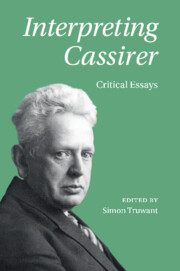Book contents
- Interpreting Cassirer
- Interpreting Cassirer
- Copyright page
- Contents
- Contributors
- Acknowledgments
- Abbreviations
- Introduction
- Part I Cassirer’s Philosophy of Culture
- Chapter 1 Interaction between Language and the Other Symbolic Forms
- Chapter 2 The Status of Art in Cassirer’s System of Culture
- Chapter 3 Being in Time
- Chapter 4 Science As a Symbolic Form: Ernst Cassirer’s Culture of Reason
- Chapter 5 Quantum Mechanics As the Ultimate Mode of Symbol Formation
- Chapter 6 Spirit in the Age of Technical Production
- Chapter 7 Political Myth and the Problem of Orientation
- Part II Cassirer’s Philosophy of Consciousness
- Part III Cassirer’s Philosophical Method
- Bibliography
- Index
Chapter 2 - The Status of Art in Cassirer’s System of Culture
from Part I - Cassirer’s Philosophy of Culture
Published online by Cambridge University Press: 17 April 2021
- Interpreting Cassirer
- Interpreting Cassirer
- Copyright page
- Contents
- Contributors
- Acknowledgments
- Abbreviations
- Introduction
- Part I Cassirer’s Philosophy of Culture
- Chapter 1 Interaction between Language and the Other Symbolic Forms
- Chapter 2 The Status of Art in Cassirer’s System of Culture
- Chapter 3 Being in Time
- Chapter 4 Science As a Symbolic Form: Ernst Cassirer’s Culture of Reason
- Chapter 5 Quantum Mechanics As the Ultimate Mode of Symbol Formation
- Chapter 6 Spirit in the Age of Technical Production
- Chapter 7 Political Myth and the Problem of Orientation
- Part II Cassirer’s Philosophy of Consciousness
- Part III Cassirer’s Philosophical Method
- Bibliography
- Index
Summary
In this chapter, Samantha Matherne solves a number of tensions in Cassirer’s dispersed writings about art. Does art align with the “expressive” or the “representative” function of consciousness? And is art, like myth and religion, a cultural domain that we are supposed to surpass toward mathematics and natural science, or is it also situated on the highest rungs of human culture? Matherne first argues that Cassirer defends a cognitivist rather than an expressivist theory of art, according to which art represents the intuitive forms of external objects and emotions. Next, she attributes to Cassirer a “liberal” theory of cultural teleology, which allows for culture to progress toward different goals. On this basis, she holds that, for Cassirer, although mathematics and natural science are more advanced than art with respect to progress toward conceptual knowledge, art is more advanced than all the other symbolic forms when it comes to intuitive insight.In this way, Matherne elucidates not just the place but the place of priority that art has in Cassirer’s system of culture.
- Type
- Chapter
- Information
- Interpreting CassirerCritical Essays, pp. 34 - 52Publisher: Cambridge University PressPrint publication year: 2021
- 3
- Cited by

